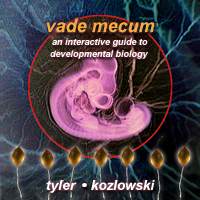







|
|
 - Prev Page
-
- Vade Mecum: An Interactive Guide to Developmental Biology
- Mary S. Tyler and Ronald N. Kozlowski
- ISBN 0-87893-842-7
- Sinauer Associates, Inc. 2000
- PREFACE
- Vade Mecum: An Interactive Guide to Developmental Biology is a CD-ROM that takes the student through the developmental cycles of a number of the model organisms used in developmental biology and illustrates techniques used in studying these organisms. Its name, Vade Mecum, comes from the Latin for "go with me," but means, in its richer context, "accompany me on my journey." In the past, the term Vade Mecum has been used to designate a manual or handbook. This Vade Mecum is meant to be a "manual" that will "go with you," both teachers and college students, as you explore developmental biology in all its beauty and complexity. With over 130 interactive videos and 300 labeled photographs, the CD-ROM includes chapters on: the slime mold, Dictyostelium discoideum; planarian; sea urchin; the fruit fly, Drosophila melanogaster; chick; and amphibian. There is a chapter on the risks of ultraviolet radiation and its effects on sea urchin development. Within each chapter are embedded "how-to" instructions on techniques used in studying the organisms - from obtaining gametes from a sea urchin to dissecting imaginal discs from a fruit fly larva. Where useful, color-coding is superimposed on living embryos to illustrate positioning of different germ layers. Included is a complete set of cross-sections of a 33-hour chick embryo and whole mounts with definitions of terms on rollover. Several "purely techniques" chapters are included as well. One, on making the most of the microscope, includes a "virtual microscope" which teaches how to achieve Koehler illumination, dark-field illumination and how to use polarizing filters. Two other chapters illustrate, in a step-by-step manner, how to make microdissecting tools and how to do histological techniques for paraffin sections. For each chapter, there is a set of study questions and websites. Also included are slide shows on laboratory safety and how to navigate through the CD-ROM.
- SYSTEM REQUIREMENTS
- For PC/Windows: Pentium II CPU, 200 MHz or faster (Pentium III recommended), Windows 95/98/NT or later, 20â25 MB RAM (30â35 MB with Netscape), 8X CD-ROM drive or higher, Windows-compatible sound-card, QuickTime 4.0 (installer provided). Internet connection and Netscape/Internet Explorer are optional.
- For Macintosh: 7600/132 (G3 or greater highly recommended), System 8.5 or later, 20, 23 MB RAM (30, 35 with Netscape), 8X CD-ROM drive or higher, 800x600 resolution and thousands of color monitor or higher, QuickTime 4.0 (installer provided). Internet connection and Netscape/Internet Explorer are optional.
- TABLE OF CONTENTS
- 1. Tools
- 2. Microscope
- 3. Histotechniques
- 4. Slime mold
- 5. Gametogenesis
- 6. Sea urchin
- 7. Sea urchin--UV
- 8. Fruit fly
- 9. Chick--early
- 10. Chick--mid
- 11. Chick--late
- 12. Flatworm
- 13. Amphibian
-
- Prev Page
-
|
|











